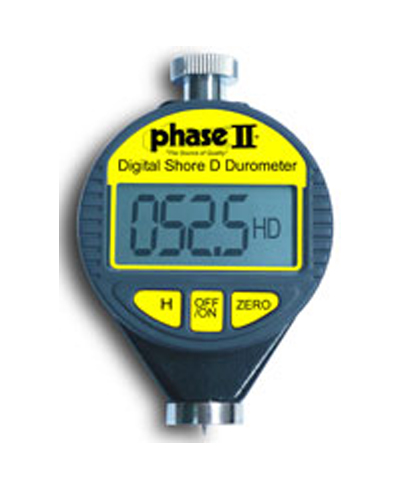ENG / 中文
Shore D Durometers
Model No. PHT-980
FEATURES:
CERTIFICATION: The units are not designed to ASTM specifications and cannot be certified as such.
Shore D scale is for testing the following materials:
Rubber: Hard
Plastics: Harder grades such as rigid thermoplastics, plexiglass, thermoploystrene, vinyl, sheet, cellulode acetate, thermosetting
Laminates (ie formica)
Other: Paper filled calendar rolls, calendar bowls, etc. (materials that would not normally indent under fingernail pressure, such as a pocket comb or bowling ball).
Specifications:
- Measuring range: 0-100 HSA/HSD
- Resolution: 0.5H
- Digital read out
- Auto Hold feature
- Uses 1-SR44 Button Cell Battery
- Custom rugged carry case
Designed to test the hardness of Rubbers and Plastics
These sleek hand held hardness testers are crafted and engineered to perform at the highest level of accuracy. An ergonomic lightweight design assists in taking precise and consistent hardness measurements.
The Shore durometer is a device for measuring the hardness of a material, typically of polymers, elastomers, and rubbers .[1]
Durometer or Shore durometer is a standardized way to measure the hardness of materials like rubber (elastomers) and plastics. Durometer measurement scales range from 0 to 100 but there is no such thing as a durometer unit of measurement. Another way of saying this is that durometer is a dimensionless measurement.
Durometer numbers simply represent a relative comparison of hardness between different but similar materials that have had their hardness measured using the same durometer scale, device and measurement standard.
In general, a higher durometer elastomer is harder than a lower durometer elastomer. For example, a 90A durometer polyurethane tubing is harder than a 70A polyurethane tubing.
Higher numbers on the scale indicate a greater resistance to indentation and thus harder materials. Lower numbers indicate less resistance and softer materials.
The term is also used to describe a material’s rating on the scale, as in an object having a “‘Shore durometer’ of 90.”
The Shore scale was defined by Albert Shore, who developed a suitable device to measure hardness in the 1920s. It was neither the first hardness tester nor the first to be called a durometer, but today that name usually refers to Shore hardness; other devices use other measures, which return corresponding results, such as for rockwell hardness.
There are several scales of durometer, used for materials with different properties. The two most common scales, using slightly different measurement systems, are the ASTM D2240 type A and type D scales.
The A scale is for softer ones, while the D scale is for harder ones.
However, the ASTM D2240-00 testing standard calls for a total of 12 scales, depending on the intended use: types A, B, C, D, DO, E, M, O, OO, OOO, OOO-S, and R. Each scale results in a value between 0 and 100, with higher values indicating a harder material.[2]
The ASTM D2240 standard recognizes twelve different durometer scales using combinations of specific spring forces and indentor configurations. These scales are properly referred to as durometer types; i.e., a durometer type is specifically designed to determine a specific scale, and the scale does not exist separately from the durometer.
Shore Durometer, like many other hardness tests, measures the depth of an indentation in the material created by a given force on a standardized presser foot. This depth is dependent on the hardness of the material, its viscoelastic properties, the shape of the presser foot, and the duration of the test. ASTM D2240 durometers allows for a measurement of the initial hardness, or the indentation hardness after a given period of time. The basic test requires applying the force in a consistent manner, without shock, and measuring the hardness (depth of the indentation). If a timed hardness is desired, force is applied for the required time and then read. The material under test should be a minimum of 6 mm (0.25 inches) thick.[3] Theoretical background of the test is considered e.g. in[4]

